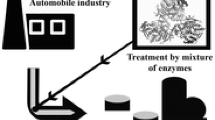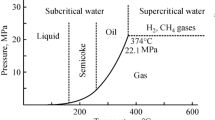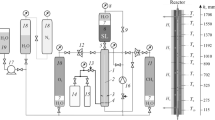Abstract
The scrubber liquid of an automobile varnish shop, where varnish particle, pigments and resins are washed out, contains microorganisms, that are able to degrade the main compounds of the solvents in the waste gases, i.e. n-butanol, ethylbenzene and structural isomers of xylene, ethyltoluene and trimethylbenzene. The concentration of the compounds in the varnish waste water to be purified oscillated between 1000 and 1 ppm. The specific degradation efficiency could be increased 4 to 12 times by improvement in oxygen supply.
A further enhancement was achieved by continuous addition of organic solvents in the gas phase. During the cultivation the number of different microorganisms of the mixed culture in the scrubber liquid was reduced. The biological system was also very stable and not sensitive to fluctuation in the solvent supply. Differences in the degradation capacity of structural isomers take place at the same concentration of aromatic hydrocarbons. The elimination of 2- or 4-ethyltoluene and 1,3,5- or 1,2,3-trimethylbenzene were 10 to 25% lower than 3-ethyltoluene or 1,2,4-trimethylbenzene.
Similar content being viewed by others
References
Kohler, H.; Lachenmeyer, U.; Homans, W.; Paul, E.: Reduzierung von Lösungsmittelemissionen aus Lackieranlagen durch biologische Abluftaufbereitung. Metalloberfläche 35 (1981) 121–125
Knappe, E.; Srna, C.: Produktion von Beschichtungsstoffen (Lackfabriken) In: Handbuch der Abwassertechnik, Band VI, organisch verschmutzte Abwässer sonstiger Industriegruppen, 3. überarbeitete Auflage, 247–290, Verlag Ernst/Sohn 1986
Feige, I.; Müller-Hurtig, R.; Wagner, F.: Biological treatment of varnish waste water in the airscrubber of an automobile shop. Dechema Biotechnology Conference, Vol. 3, Part B, Frankfurt, 708–711, 1989
Feige, I: Untersuchungen zur Einsetzbarkeit eines Luftwäschers einer Fahrzeugdecklackspritzlackiererei als biologische Reinigungsstufe for lösungsmittelhaltige Abluft. Thesis, TU Braunschweig 1991
Bergmeyer, ▪.: Methods of enzymatic analysis, 3. Edition, Volume II, Samples, Reagents, assessment of results, Verlag Chemie 1986
Ewald, M.; Hermann, K.; Weidmann, M.: Kurzzeittest für die Bestimmung der Dehydrogenaseaktivität von Belebtschlämmen. Vom Wasser 68, 1987, 165–175
Kohler, H.: Behandlung geruchsintensiver Abluft in Wäschern unter Verwendung einer Belebtschlammsuspension. Fortschritts-Berichte VDI, Reihe 15, Nr. 22, 31–51, Düsseldorf, VDI-Verlag 1982
Kobayashi, H.; Rittmann, B. E.: Microbial removal of hazardous organic compounds. Environ. Sci. Technol. 16, 1982, 170A-183A.
Vonier, B.: Feststoffabscheidung aus Spritzkabinenabluft und Bestimmung der Staub- und Gesamt-C-Emission. WLB Wasser, Luft und Boden 3, 1990, 52–54
Meier, R.; Müller-Hurtig, R.; Wagner, F.: Bioprocess Engineering (accepted for publication)
Author information
Authors and Affiliations
Rights and permissions
About this article
Cite this article
Feige, I., Müller-Hurtig, R. & Wagner, F. Biodegradation of solvents in varnish waste water of an airscrubber from an automobile varnish shop. Bioprocess Engineering 7, 291–295 (1992). https://doi.org/10.1007/BF00705156
Received:
Issue Date:
DOI: https://doi.org/10.1007/BF00705156




